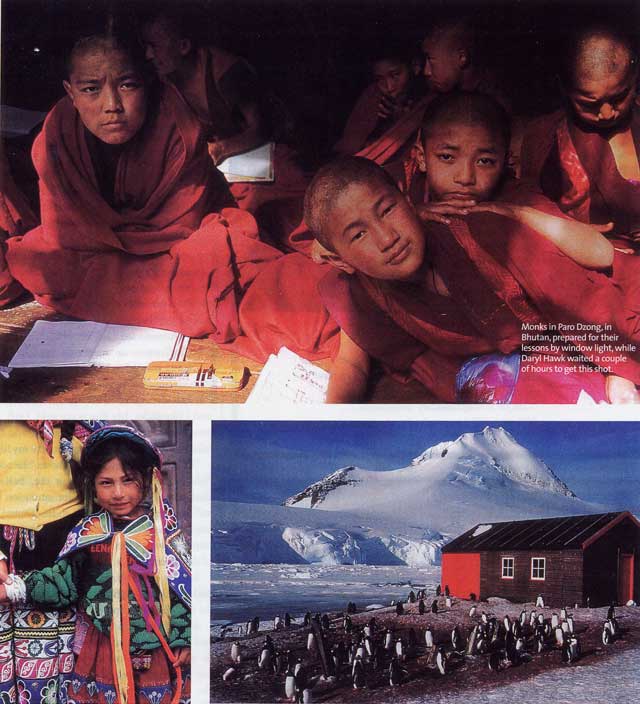
PHOTOGRAPHER DARYL HAWK loves traveling the world alone for one-of-a-kind-shots and then coming home to enjoy family life in Wilton.
AS BEFITS A PHOTOGRAPHER, Hawk is a study in contrasts. Relaxing in his 1930 farmhouse-style home in a woodsy section of south Wilton, he looks every bit the Fairfield County soccer dad. His winter-print sweater, turtleneck, jeans, socks, even his soft suede shoes coordinate perfectly. The home studio is filled with antiques and mementoes of four-and-a-half decades of hardy New England living. With his wife, Heidi, and their two school-age boys out for the day, it’s Chloe, the family golden retriever, who bounds to the front door to greet him.
Yet there are hints that speak of Hawk’s other life: foreign license plates pegged along the entire length of a ceiling beam; framed prints of larger-than-life nature scenes from Patagonia, Zion National Park and Machu Picchu; exotic flags displayed on a wall; a globe in the centerof the room. Welcome to the two sides of Daryl Hawk, child of southern Connecticut, and adventurer and photographer of the world’s most remote locales.
Even as a photographer, Daryl has fiercly distinct personas. On any given day, he’s as likely to be found shooting a portait of a corporate executive in his full-service studio as he is traipsing around Manhattan shooting black-and-white slides, or in Antarctica, or perhaps Bhutan, going where few have gone before and bringing back his own unique trophies: rare scenes of stunning nature and native people.

“I always knew I was going to live a life of adventure,” says Daryl, “but I had no idea how that was going to turn out.” Raised in Westport, he never ventured much farther than his family’s New Hampshire summer camp as a boy, where he learned to love nature. It was his grandparents who fitted his eye behind the viewfinder, in the form of a Polaroid camera when he was twelve. “The whole idea of taking a photo, looking at it and putting it in a scrapbook. knowing that would be there for eternity, fascinated me,” says Daryl.
After he graduated from Staples High School in 1975, never having heard of Jack Kerouac, Daryl went on the road, on his first great journey. Armed with camping gear, his manual Nikon SLR and a spirit of adventure, he took off in a 1971 Chevy Impala station wagon for points west. “I was free as the wind, could come and go as I wanted, having all these adventures,” he recalls. ” Experience as a camper taught me not only how to be in the woods, but how to overcome loneliness and fear of the unknown.”
And yet he chose to go to Connecticut College, in New London.”Daryl says. “I never considered going away to college,” Daryl says. “I love New England, I love it as a home base.” At school he took photography courses and flirted with the idea of becoming a writer, but worried about making a living at it. “Besides,” he says, “I always loved photography best.”
After college he learned the art and science of studio photography by setting up lights and working alongside mentors. He also fell in love. “It sounds a little corny, but it’s true,” he begins. “I was at a country fair with a friend, and heidi was, too. We were both just walking around and made eye contact. For me it was love at first sight,” he says with a slow grin. ” She took a little longer.”

They found a place to live in the Old Mill Beach area of Westport. In a neat flash of synchronicity, she was working on the business side of Popular Photography and American Photography magazines. When Hawk’s photography began to soar, she traded her monthly commuter pass for a job at home as his business manager. They found their dream property on Bossy Lane – a classic fixer-upper on two wooded acres with stone-tiered gardens. In short order, their sons Justin and Brandon came along.
In between those perfect suburban lines, however, another life was developing. Daryl was expanding his horizons as a travel photographer and forging a travel style that’s as essential to his work as his Nikon SLR’s. “Traveling is like breathing and eating to me,” he say’s. ” And because I like places all to myself, I travel to remote regions, alone, in off-seasons. I want to immerse myself in a culture and meet people and spend some time with them and hear their stories and learn about their lifestyles before I start photographing them.
“When I come back home, ” Daryl says, ” I have better perspective on things.”
Daryl and Heidi have traveled together across the United States and to every Canadian province and territory, “experiencing all the great things that North America has.” The photos are stunning, conveying both a sense of those countries’ vastness, through sweeping landscapes, as well as their intimate sides, in the faces of the people met along the way. “My mission,” says the photographer, his voice gaining strength with each sentence, ” is to document the world as I see it right now. One it changes, it will never be the same again. My way of preserving these places is by showing the real beauty through photography.
“Nature is very much a part of who I am, and I try to give back to nature all that it’s given to me,” he says. “One of my goals in life, with my photography and travel and enlightening people, is to do whatever I possibly can make people realize we have to protect and preserve the last wide-open and wild places on earth.


I use my photographs to try to get across the message that this is worth preserving. People think we can just do whatever we want to this planet, and take things for granted, but if we lose nature, we’re going to lose everything.”
Daryl’s trips – or journeys, as he prefers to call them – have brought him through backcountry Central America, remote reaches of Bolivia and Peru, across Argentina’s ruggedly stunning Patagonia. “I’d research as much as I could, then I’d piece together an itinerary. But I never make hotel reservations before I leave;that’s the kiss of death. I never have problems getting a room, because the places I’m going to, there’s never anyone around anyway. You’re lucky if you can find a hotel.”
Daryl feels as strongly about what he does as how he does it. “I need to go where I want, stay as long as I want. I can’t shoot from a photo list, I can’t be checking in with editors on satellite radios. I believe in totally breaking off communication with the outside world when I travel.
“People always want to come with me, carry my bags or my camera equipment, but I politely tell them that I can’t do it because I’m shooting from dawn to dusk nonstop and can’t have distractions. One
of the underlying themes in my work is that I have to be free. I shoot pure and travel free. At heart, I’m really a loner in a lot of ways.”
And then he comes home to Wilton and becomes the other Daryl Hawk, the one who can saay without a hint of insincerity, “I’ve always considered myself a family man first, and the thought of being away more than a month is something I couldn’t consider.” A month, as it happens, is precisely the time he was away on his most recent journey, to Bhutan last November.



BOTTOM, LEFT: A young girl and her grandmother show off the bright colors of Peru. BOTTOM, RIGHT: An abandoned and perfectly preserved British research station provided an unusual spark of color in Port Lockroy, Antarctica.
“I had a more intense desire to see Bhutan than any other place in my whole life, “he says, his voice once again rising in pitch. “I spent a year researching it and realized Bhutan had everything. It’s a wide-open country, untouched by time, with surreal architecture, 100 percent Buddhist, landscapes of powerful nature, and pure rivers as clear as glass and waterfalls racing over roads, and birds and animals from snow leopards to red pandas to blue sheep. It’s a wildlife wilderness paradise; an untouched, undiscovered perfect little world that I had almost completely to myself.”
Daryl has big plans for the 235 rolls of slides and scores of hours of moving film he shot while there, including an hour-long documentary on his television program, The Unconventional Traveler (Channel 77, Tuesdays at 9 p.m.), and slide-show lectures at the Wilton Art Gallery on March 6 – and even a book of the journey. “I truly believe it was my destiny to be there at this given time,” he says. “I’m still not exactly sure why, but I’m sure the reasons will unfold next year as people start seeing the work.”
And the work is extraordinary: Himalayan panoramas, smiling children, serene monks, rare Buddhist ceremonies and festivals, all shot on one of Daryls’s two Nikons(still manual), mostly shot on 100 ASA Fuji Velvia Provia transparency film, and a 28-200mm lens. He also brings along a 24mm and a 20mm wide-angle lens for landscapes. But, he cautions, “if you start taking off lenses in remote places where you have wind and dust and snow, you’re opening yourself up to trouble. And the places I go to, you can’t afford to have a problem with the camera.”
A professed Luddite who offers Henri Cartier-Bresson as a roll model, Daryl loves his old-fashioned ways. “I’ll never give up film, never, ever! I like waiting, I like wondering. I like the quality of film, and I like the slides. My film is my gold. I tell people you can take my money, you can take my passport, but do not take my film.
“I also like giving slide shows,” he adds “Many people, including me, believe sharpness, clarity, the color saturation are still superior with color slides. Digital to me doesn’t seem the same. Even if digital improved, I wouldn’t change. I have a way of doing things.”
So Daryl Hawk sits in his easy chair and spins that finger-worn globe, “looking for the blank spaces.”
Editing and sharing his Bhutan slides and documentary will keep him busy, as well as close to home, for a while, but his mind is always dancing with the prospect of new far-off destinations: “Botswana, Zimbabwe, South Africa – but not the desert: the light is too harsh. New Zealand, Australia – that would be a family trip. I’d love to go to both the North Pole and the South Pole. Mongolia is very high on my list, as are Burma, India, a trek in Nepal from Katmandu to Ladakh, Tibet, Thailand, northern mountains of China – there’s a road trip all the way across to the Tibetan plateau. Greenland has always fascinated me… .” For Daryl Hawk, the journey is never ending.
